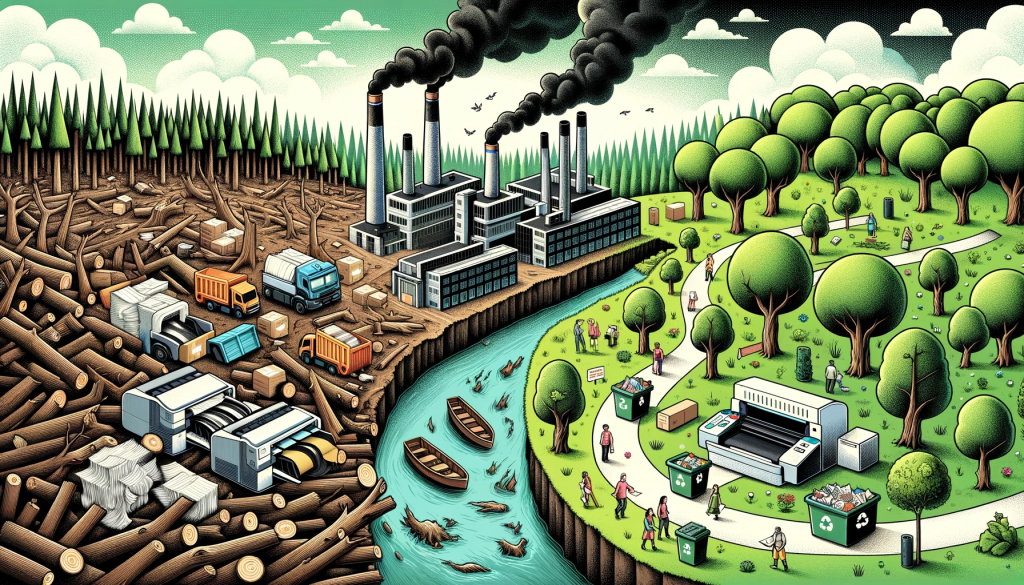
In an era where environmental consciousness is not just a choice but a necessity, understanding and mitigating the environmental impact of our daily activities is crucial. Among these activities, printing plays a significant role, often overlooked in discussions about eco-friendly practices. This article delves into the environmental implications of printing and explores various strategies to reduce waste and promote recycling, focusing on eco-friendly printing practices, sustainable alternatives, and responsible recycling methods.
Understanding the Environmental Impact of Paper Production
The journey towards eco-friendly printing begins with an understanding of the environmental impact of paper production. Paper production is a resource-intensive process, involving the cutting down of trees, substantial water usage, and energy consumption. It also contributes to deforestation, habitat destruction, and greenhouse gas emissions. According to the Environmental Paper Network, the paper industry is one of the world’s major contributors to deforestation and climate change.
To mitigate these impacts, businesses and individuals can adopt sustainable alternatives to traditional printing. This includes using recycled paper or paper sourced from sustainably managed forests. Eco-conscious paper brands often carry certifications like the Forest Stewardship Council (FSC) or the Programme for the Endorsement of Forest Certification (PEFC), which assure consumers that the products are sourced from responsibly managed forests.
Reducing Paper Waste in the Office
Reducing paper waste in the office is a critical step towards minimizing your ecological footprint through printing. Here are some strategies:
- Digitalization: Embrace digital tools for document sharing and storage. Utilizing cloud services and digital collaboration tools can significantly reduce the need for printed materials.
- Double-Sided Printing: When printing is necessary, use double-sided printing to halve the amount of paper used.
- Print Management Software: Implement software that tracks and manages printing within your organization, helping to identify areas where paper usage can be reduced.
- Eco-Friendly Print Settings: Use eco-friendly print settings, such as draft mode, which uses less ink and is suitable for internal documents.
- Awareness and Training: Educate employees about the importance of reducing paper waste and provide training on eco-friendly printing practices.
Green Printing Solutions for Businesses
Businesses can adopt green printing solutions to further reduce their environmental impact. These include:
- Energy-Efficient Printers: Invest in energy-efficient printers with automatic sleep modes to reduce energy consumption.
- Eco-Friendly Ink: Use soy or vegetable-based inks, which are less harmful to the environment compared to petroleum-based inks.
- Managed Print Services (MPS): MPS providers can optimize a business’s print environment, reducing waste and improving efficiency.
- Sustainable Printing Materials: Beyond paper, consider other sustainable materials like biodegradable plastics for 3D printing.
Recycling Printer Cartridges Responsibly
Printer cartridges are a significant source of waste in the printing process. They contain plastics, metals, and residual ink, which can be harmful to the environment if not disposed of properly. Recycling printer cartridges responsibly involves:
- Using Refillable Cartridges: Refillable cartridges can be used multiple times, significantly reducing waste.
- Recycling Programs: Participate in manufacturer or third-party recycling programs that take back used cartridges for proper disposal or refurbishment.
- Buying Recycled Cartridges: Purchase remanufactured cartridges, which are often cheaper and just as effective as new ones.
Reuse Paper for Creative Projects
Reusing paper for creative projects is a fun and effective way to reduce waste. Offices and schools can set up systems to collect used paper for:
- Craft Projects: Used paper can be a great resource for art and craft projects in schools and community centers.
- Note-Taking: Encourage employees or students to use the blank sides of used paper for notes.
- Packing Material: Shredded paper can be used as an eco-friendly packing material.
Eco-Conscious Paper Brands and Certifications
When purchasing paper, look for eco-conscious brands that carry environmental certifications. These certifications ensure that the paper is produced sustainably and with minimal environmental impact. Some key certifications to look for include:
- Forest Stewardship Council (FSC): The FSC certification is considered the gold standard for wood harvested from forests that are responsibly managed, socially beneficial, environmentally conscious, and economically viable.
- Programme for the Endorsement of Forest Certification (PEFC): PEFC promotes sustainable forest management through independent third-party certification.
- EU Ecolabel: This label is awarded to products and services that meet high environmental standards throughout their life-cycle.
Minimize Your Ecological Footprint Through Printing
To minimize your ecological footprint through printing, it’s essential to adopt a holistic approach that encompasses the use of sustainable materials, efficient printing practices, and responsible waste management. Here are some final tips:
- Conduct a Print Audit: Assess your current printing practices and identify areas for improvement.
- Set Sustainability Goals: Establish clear, achievable goals for reducing paper and cartridge waste.
- Engage with Eco-Friendly Suppliers: Partner with suppliers who are committed to environmental sustainability.
- Regularly Review and Adjust Practices: Continuously monitor your printing practices and make adjustments as needed to ensure ongoing sustainability.
In conclusion, the environmental impact of printing is significant, but with conscious efforts and the adoption of eco-friendly practices, businesses and individuals can make a substantial difference. By reducing paper waste, recycling cartridges responsibly, and choosing sustainable alternatives, we can collectively work towards a more sustainable and environmentally responsible future.
TonerCartridgeDepot.com, a prominent online store for printing supplies, has taken a commendable step towards environmental sustainability with its cartridge recycling program. This initiative is specifically designed to address the environmental concerns associated with printing, particularly the disposal of used and unused cartridges.
The program’s primary objective is to reduce the environmental impact of printing by providing a responsible and convenient way to dispose of cartridges. Customers can send their used or unused cartridges to TonerCartridgeDepot.com, where they are either refurbished for reuse or recycled in an environmentally friendly manner. This process not only helps in diverting waste from landfills but also reduces the need for new raw materials to manufacture new cartridges, thus conserving natural resources and reducing carbon footprint.
By participating in this recycling program, customers of TonerCartridgeDepot.com contribute to a circular economy, where products are reused and recycled, minimizing waste and environmental impact. This initiative aligns with the growing global movement towards sustainable practices and demonstrates TonerCartridgeDepot.com commitment to eco-friendly business practices.
